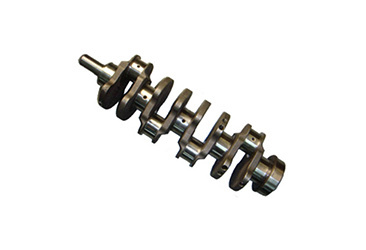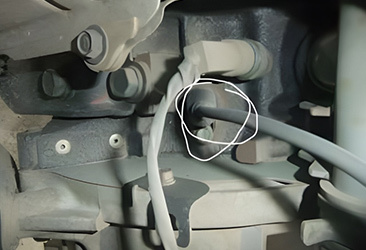Failure analysis of engine crankshaft rolling bearings
Release time:
2020-09-16
The engine crankshaft of some small wheeled tractors is supported by two rolling bearings. Rolling bearings consist of an inner ring, an outer ring, rolling elements, and a cage.
The crankshaft of some small wheeled tractors is supported by two rolling bearings. The rolling bearing consists of an inner ring, outer ring, rolling elements, and a cage. There are raceways on the outside of the inner ring and the inside of the outer ring to facilitate the rolling of the rolling elements. The inner ring fits with the shaft, while the outer ring fits with the bearing seat or housing. Typically, the inner ring rotates with the shaft while the outer ring does not.
The main journal necks at both ends of the crankshaft are fixed to the inner rings of the rolling bearings, while the outer rings of these bearings are secured in place within the bearing seat hole by rear bearing caps to prevent axial movement. The outer ring of the front bearing is directly installed in the seat hole of the housing without axial fixation, allowing for axial expansion when heated.
Once a failure occurs in a crankshaft's rolling bearing, it directly affects the technical condition of the engine; therefore, attention should be paid to failures in rolling bearings. Common failures include wear, deformation, or breakage of bearing cages. The lubrication for crankshaft bearings is splash-type. When there is a lack or absence of lubricating oil in a bearing—especially under heavy loads—the temperature rises significantly. The temperature of the inner ring can be about ten degrees higher than that of the outer ring due to different thermal expansions causing loss of clearance between balls and raceways, which can easily lead to cage breakage during operation. Therefore, clean lubricating oil should be applied inside raceways during installation to prevent dry friction when lubrication fails.
Increased radial and axial clearances occur due to wear from dry friction during startup and excessive friction wear. This is mainly caused by metal particles from component surfaces and sand, dust, or dirt in lubricating oil that create friction on rolling elements and raceways. Wear from abrasives significantly increases clearance between rings and rolling elements; dull surfaces form on raceways along with uneven scratches. To prevent this issue, lubricating oil should be replaced regularly; oil fill holes must be sealed tightly to prevent dirt ingress.
Clearance appears due to movement between inner and outer rings as well as wear on mating parts; movement occurs at inner rings. The fit between rolling bearings' inner rings and journal necks is an interference fit. The maximum interference for front bearing inner diameters is 0.055mm while minimum interference is 0.012mm; for rear bearings it’s 0.046mm maximum interference and 0.003mm minimum interference. From this perspective on fitting: if a bearing has been disassembled several times leading to gaps between its inner ring and journal necks, repairs must be made before reuse.
Movement occurs at outer rings as well. For ease of disassembly/assembly, an interference fit is used between rolling bearing outer rings and their seat holes. Maximum interference for front bearing outer rings is 0.035mm with maximum clearance at 0.013mm; for rear bearings it’s a maximum interference of 0.016mm with maximum clearance at 0.06mm during assembly measurements—interference or clearance must not exceed these ranges; otherwise repairs will be needed.
When there’s looseness in fitting between shafts and bearings, some repair workers roughen up loose-fitting shaft surfaces using embossing or punching methods aiming for tighter fitting surfaces through texturing them—this approach not only damages geometric shapes but also leads to misalignment during installation preventing proper centering which ultimately results in loosening as textured areas flatten out over time under pressure instead of achieving tightness through proper methods like grinding followed by plating or spraying after repairs.
Flaking occurs on raceway surfaces due to external hard particles entering contact areas between housings or shafts causing distortion in shape where pressure from rolling elements peaks leading quickly into rapid wear resulting in metal flaking off those areas too since they’re highly sensitive components requiring cleanliness throughout maintenance processes using non-fuzzy cloths strictly avoiding old cotton fibers which could introduce harmful debris into lubricants affecting performance adversely—thorough cleaning before assembly ensures no contaminants enter mating surfaces.
Flaking caused by impact loads and alternating stress arises when periodic pulsating loads act upon both internal/external races along with roller bodies creating cyclic variations in contact stresses leading eventually into fatigue flaking once cycles reach certain thresholds especially exacerbated under excessive loading conditions alongside improper installations or bent shafts contributing further towards premature failures seen often within flywheels/pulleys balancing inertial forces against rotating components ensuring no unbalanced moments exist otherwise vibrations increase stress cycles leading prematurely into surface degradation requiring careful operational practices avoiding excess loads/vibrations maintaining regular checks on securing bolts preventing loosening issues.
Damage caused by improper installation resulting from pressure applied through external races onto steel balls inevitably creates pits where contact occurs leading directly towards failure mechanisms escalating rapidly rendering bearings unusable within short timeframes hence specialized tools should always be utilized ensuring even distribution across force application points during disassembly.
Latest News









